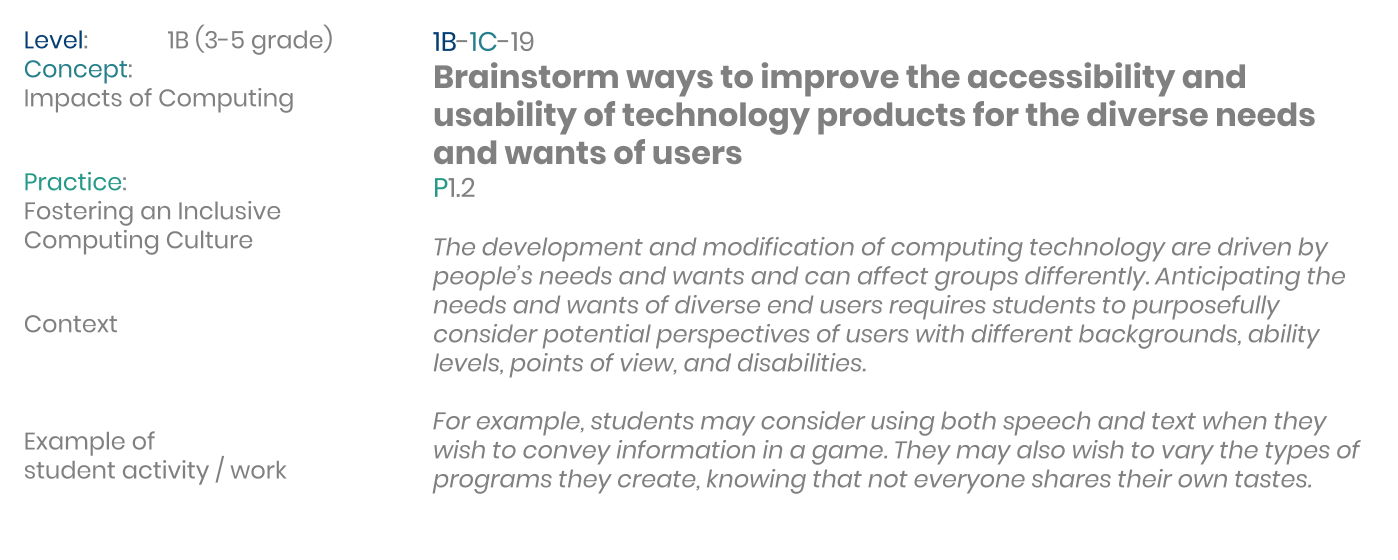Contexts are the many things teachers must take into consideration when designing and implementing CS activities. These include, but are not limited to:
-
Learners’ variability: How will the unique needs of all students (including those with special needs and English language learners) be met? In what ways will students’ culture and background experiences be considered?
-
Schedule and structure: Where does CS “fit” into the school/class schedule and curriculum? Examples: Independent “stand-alone” CS classes, Integrated into other subject areas
Content describes what teachers need to teach and what students need to learn. Resources in the PA CS Teacher Toolkit are aligned to the Pennsylvania-endorsed
CSTA standards and address five core concepts and seven core practices.
CS Standards
In January 2018 the Pennsylvania State Board of Education endorsed the 2017 Computer Science Teachers Association (CSTA) K-12 Computer Science Standards. Local education agencies (LEAs are encouraged to voluntarily adopt these standards to guide the implementation of Computer Science education.
About the CS Standards
The standards are designed to:
- Introduce the fundamental concepts of CS to all students, beginning at the elementary school level.
- Present CS at the secondary school level in a way that can fulfill a computer science, math, or science graduation credit.*
- Encourage schools to offer additional secondary-level CS courses that will allow interested students to study facets of computer science in more depth and prepare them for entry into the workforce or college.^
- Increase the availability of rigorous computer science for all students, especially those who are members of underrepresented groups. 1
The CS standards are organized in grade-level bands, providing flexibility for LEAs in determining how to address them, however; it may take time to acclimate to the way that the standards are organized and named.



This graphic depicts what information is provided for each standard. For more information on the CS concepts and practices, explore the K-12 CS Framework. 2

High School CS
* Act 86 (signed into law on July 13, 2016) amended section 1605 of the Pennsylvania Public School Code to allow high school students to apply up to one credit towards a math or science high school graduation credit requirement upon successful completion of computer science or information technology coursework. 3
^Standards in the 3B grade level band are designed for use in advanced elective courses, not general pathways. Courses aligned to the 3B standards are for students who have demonstrated mastery of all 1A - 3A standards and are interested in pursuing CS education beyond their K-12 experience.
Resources
CS Priorities
This document identifies areas of focus in instruction and critical standards for Computer Science instruction in grades K-2. Where applicable, potential cross-content connections are provided.
K-12 CS Framework
Learn more about the CS concepts and practices addressed by the CS standards.
CSTA
Use the “Explore the Standards” tool to find standards by grade level, CS concepts, and CS practices.
Note: A CSTA membership (basic membership is free) is required to access the standards through the CSTA website. PDF versions of CSTA resources are available here:
Technology in CS education includes CS-specific tools in addition to educational technology commonly used across content areas (i.e. interactive whiteboards, learning management systems).
CS-specific technology includes:
Programming Languages: Languages that developers use to comprise a set of instructions in computers
Examples: Java, Java Script, Python, HTML, C++, and Visual Block-based coding.
Programming Platforms: (ie. Integrated development environment): Platforms are where you use a language. For some languages, there are many platforms for writing and preparing your code. Conversely, a platform can also contain more than one language. The platform often includes a user interface, code editor, automation tools, debugging tools and online depository.
Examples: Scratch, MakeCode
Physical Tools and Devices: Tools that would allow users to control, program and interact with programming in a tangible way, such as with robotics and/or microcontrollers
Examples: Sphero, Micro:bit, Lilypad Arduino
CS Pedagogy (the approach to teaching) involves research-based practices and strategies consistent with or adapted from those used across subjects, such as:
- Pair Programming
- Think-Pair-Share
- Direct Demonstration and Modeling (ex. I do, We do, You do)
- Hands-on or Kinesthetic Activities: CS Unplugged
- POGIL (Process Oriented Guided Inquiry Learning)
- Reading about CS
- Learning Centers or Stations
- Jigsaw
- Project-Based, Inquiry-Based, Problem-Bbased Learning (ex, StartSOLE)
- Storyboarding
- Exit Tickets
- Rubrics
- Emphasis of the 4Cs: Communication, Collaboration, Critical Thinking, and Creativity